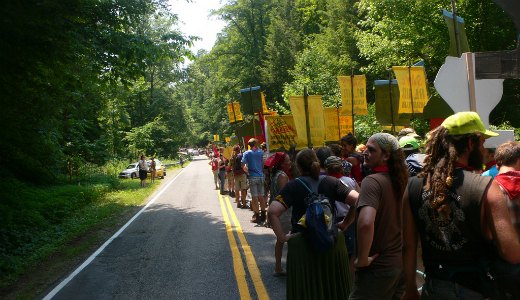
The Battle of Blair Mountain, in Logan County, West Virginia, was the largest armed insurrection since the Civil War. For five days in late August and early September, 1921, 15,000 miners confronted an army of police and strikebreakers backed by coal operators during a struggle by the miners for the right to collectively bargain, and to end horrendous working conditions and poverty in the southwestern West Virginia coalfields. One million rounds were fired and the U.S. Army, under presidential order, intervened.
Management and their shameful scab friends prevailed in the short run, but the United Mine Workers returned in the 1930s and overcame all obstacles to unionization. A monument to the battle was established on Blair Mountain – a record of and tribute to the most militant labor struggle in American history, one in which thousands of miners faced down death, imprisonment, terror, evictions from company housing and firings to defend the dignity of miners, their families and communities. The battle was memorialized in the movie Matewan, directed by John Sayles. Blair Mountain was added to the National Register of Historic Places in 2009, but coal operators pressed to have it removed in 2010. Why? Because they want to blow it up in a mountaintop removal orgy that will blot out the history, capture a few seams of coal and poison downstream waters, leaving a mountain-sized garbage dump in their wake.
Despite being an icon of labor rights, a chunk of Blair Mountain was purchased by coal operator Massey Energy. They plan to destroy it – and the legacy for which it stands. Massey Energy is already tarnished by the unsafe conditions that led to the 2010 explosion in its Upper Big Branch mine that killed 29 miners. Don Blankenship, the loudmouthed former Massey chairman, was forced to resign after saying an unacceptable number of very stupid things about the environment, climate change, and mine safety, and by attempting to buy West Virginia Supreme Court judges. Massey had to be sold to Alpha Group, a holding company sponsored in part by George Soros, to get out from under the sting of Blankenship’s blunders.
Environmental activists and celebrities from around the nation have descended on Blair Mountain as a symbol of the social and environmental costs of mountaintop removal mining. When you get to the point where wiping out – and poisoning – a complete mountain is the “only profitable” means of extracting a modest seam of coal, they said, it’s time to rethink coal mining.
During the week ending June 10, over 500 community leaders, union members, celebrities and conservationists honored the Blair Mountain battle, called for an end to surface mining and demanded safe, sustainable jobs in Appalachia in an event dubbed “Appalachia Rising: The March on Blair Mountain.” Marchers followed the same route as the coal miners who marched to Blair Mountain in 1921. Robert F Kennedy Jr. was the featured political speaker. Entertainers Ashley Judd, Emmylou Harris and others participated and contributed as well.
Numerous union members joined the weeklong march. However, the United Mineworkers of America union withdrew its early endorsement of the march because, while it opposes Blair Mountain mountaintop removal for obvious historical reasons, it does not oppose such mining in general. It is a brutal and polluting technology, but one on the remaining mining jobs in modern Appalachia are increasingly dependent. It is almost impossible for an industrial union in the U.S. labor relations environment to oppose the industrial policies of the industry in which its members work. The company owns the jobs; the unions negotiate only over some of the effects of management rights.
Environmental activists on the march were disappointed the union “kept its distance.” On the other hand, the activists have given little importance to the most profound question for coal communities: “What do we do when the coal is gone?” Where are the scholarships, retraining, health care and safety nets for them? These are heartfelt questions that cause the blood to rise among miners, but, as former Senator Robert Byrd, a man who fought long and hard to improve those protections for miners, prophesized in 2009, “The major threats to the coal industry are not regulations on mountaintop mining or other environmental laws. Rather they come from rigid mindsets, depleting coal reserves and the declining demand for coal as more power plants shift to biomass and other resources as a way to reduce emissions. West Virginians can choose to anticipate change and adapt to it, or they can choose to resist and be overrun by it.”
Photo: 800 marchers on Blair Mountain. Elias Schewel // CC 2.0

MOST POPULAR TODAY


Zionist organizations leading campaign to stop ceasefire resolutions in D.C. area

High Court essentially bans demonstrations, freedom of assembly in Deep South

Afghanistan’s socialist years: The promising future killed off by U.S. imperialism

Communist Karol Cariola elected president of Chile’s legislature






Comments